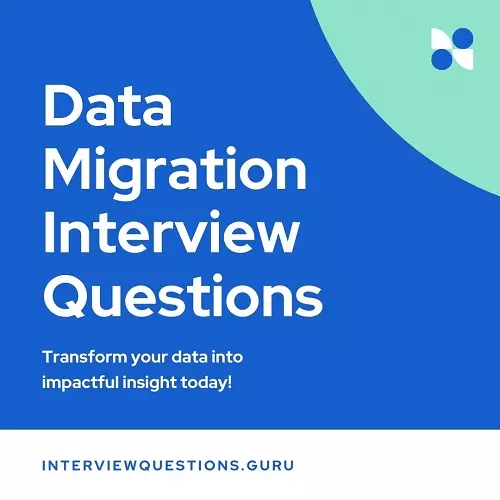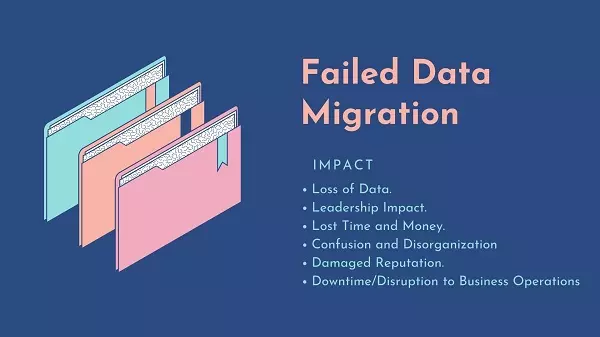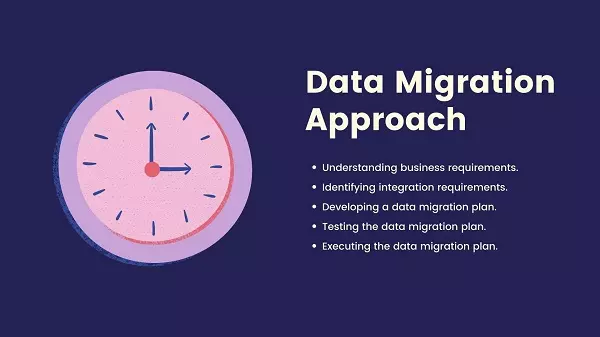Data migration is a complex task that requires you to be prepared for any possible scenario. This blog post will discuss the most common data migration interview questions and provide answers. Suppose you are looking for a job as a Data Migration Consultant. In that case, this article will give you some ideas on what companies want to know about your experience with data migration projects.
The first question that is usually asked in a data migration interview is about your experience with data migration projects. It is important to describe the different types of data migrations you have worked on, the tools you have used, and the challenges you faced during the project.
The interviewer wants to know that you have experience working with different data types and are familiar with the tools and techniques used for data migration.
Table of Contents
Data Migration Interview Questions
What is data migration, and why is it important?
Data migration is the process of transferring data from one system to another. It is important because it allows organizations to move their data to new systems or platforms, improving performance and efficiency.
Data migrations are usually done when the company decides to use a new tool for analysis, such as Tableau and wants all of their historical data available through this new platform.
Why is data migration required?
Data migration is required because of the following reasons.
New System
The company wants to start using a new system to analyze its business data better. For example, the company used Excel for reports and wants to switch to Tableau.
Company Growth
As the business grows, it requires more data analysis tools for different departments. The company may have various departments such as marketing, accounting, and human resources that need to use separate data analysis tools.
Mergers and Acquisitions
When two or more companies merge, the data from all companies need to be consolidated into one system. It is also true when a company acquires another company.
Business Requirements
The company has new business requirements that can only be met by migrating the data to a new system. For example, a company wants to meet specific compliance regulations or track inventory levels in real-time.
Data Consolidation
The company may want to consolidate all of its data into one central location. Because for multiple reasons, such as improving data quality or gaining access to different types of previously unavailable analyses.
Top Excel interview questions to ask Data Analyst
Share data migration example?
One example of data migration is the process used by MasterCard to move their customer database from Oracle/IBM DB to SAP HANA.
What is the benefit of data migration?
The benefits of data migration can vary depending on the project you are working on. Typical benefits include:
Increased Business Intelligence: Data may be migrated to a new system that provides more analysis, better reporting capabilities, etc.
Higher Quality Data: The quality of source data may not meet business requirements, creating issues with decision-making or analysis.
Creating a Foundation for New Technology: Data migration is typically the first step in technology projects that require data to be available before new tools can be implemented, such as cloud migrations or Big Data implementations.
What is a data migration service?
A data migration service is a company or individual that offers to help you with your data migration project. They can assist with all aspects of the project, from planning to execution.
What is mean by data migration in cloud computing?
In cloud computing, data migration moves data from one environment to another. It can include transferring data from on-premises systems to the cloud or transferring data between different cloud providers. It can consist of applications, databases, files, servers, etc.
What are five things you need to know about Cloud Data Migration?
There are many different types of cloud migrations, and the process can vary depending on the type of migration you are performing. However, there are some key things to be aware of:
- Multiple tools are used during the process.
- Documentation is critical: properly documenting the project will help with any contingencies.
- Testing is essential: all data should be tested before migration to ensure the accuracy and integrity of the information post-migration.
- The cloud is not always faster than on-premise systems; data needs to be analyzed and tested to ensure the best migration path.
- Data ownership can be an issue during a cloud migration. Make sure to have a plan for who will own the data once it is migrated.
What are the steps in a data migration?
The steps in a data migration can vary depending on the type of migration and your tools. However, some general steps are followed in most data migrations:
Data Preparation: This step includes identifying the source and target data, mapping the data fields, and cleansing or transforming the data.
Data Loading: This step includes loading the data into the target system.
Data Testing: This step includes verifying that the data was loaded correctly and meets all business requirements.
Data Migration: This is the final step in moving the data from one system to another.
Data Analysis: After the data is migrated, it is essential to analyze the data to understand how it was changed during the migration and identify any potential issues.
What are some best practices when performing data migration?
There are several vital things you should keep in mind while planning and executing your project:
Plan ahead: Planning early on will help reduce any downtime, problems, or issues that could arise during the migration process.
Test everything: Make sure you test the migration process thoroughly before going live. It includes testing both the source and destination systems and the data itself.
Create a backup plan: Having a good backup and disaster recovery plan is essential in case of any problems during or after the migration process.
Be prepared for glitches: There is always a risk of glitches during data migration. So, be prepared for and expect the unexpected.
What is the difference between data transfer and data migration?
The difference between data transfer and migration is that data transfer refers to moving files or database records from one system to another. In contrast, data migration refers to the entire project of transferring an application’s data.
What are four types of migration?
Types of migration can vary depending on the context. Some of the types are:
On-premise to On-Premise: Moving data from an on-premises environment to another on-premises environment.
On-Premise To Cloud: Transferring data from an existing system (on-premises) to a new system in the cloud.
Cloud to Cloud: Moving data between different cloud providers.
Cross-Platform: Transferring data between two different platforms, Windows and Linux.
What types of data can and should be migrated?
The type of data being migrated will depend on the project. However, it is typically divided into three main categories:
Production Data: This data needs to be available for end-users and includes transactional data, customer information, etc.
Archival Data: Archived or historical data that may not be needed immediately but can be accessed if required in the future.
Backup Data: This data is used for backup and Disaster Recovery (DR) purposes and may not be needed daily.
What are some common challenges you may encounter during data migration?
Some of the more common challenges include:
Large Data Set Size: Data from many tables may need to be migrated, which could increase the complexity of a project.
Complex Data Relationships: Different types of relationships may exist between different tables and columns, requiring more effort during the migration.
Data validation: Ensuring that all the data is valid and correct before migrating it can be difficult, especially if you migrate large amounts of data.
Data inconsistency: It’s vital to ensure that the source and destination systems have similar naming conventions. Otherwise, there can be problems during or after migration with differing data names.
Target format differences: If your target environment is running on another platform, it may not support all of the same data formats as the source system. It can cause problems during or after a migration.
Different Data Quality: Data quality may differ between source and target data, making it harder to match records.
Technology Limitations: Make sure you know all technical limitations before beginning your project, so there aren’t any surprises.
What is a Data Warehouse?
A data warehouse is a system or repository used to store and organize large amounts of structured, semi-structured, and unstructured data.
What are some factors you should consider when selecting the right migration partner?
It would be best if you consider different factors when deciding which company will be best for your project. Some things to consider include:
- Their experience in data migration.
- Their ability to meet your specific requirements.
- The quality of their services and support.
- How well they understand your business needs.
- Their pricing.
What is Data Extraction?
Data extraction is transferring data from a source system to a destination system.
What is Data Transformation?
Data transformation is the process of converting data from one format to another.
What are some common data transformations?
Some common data transformations include:
Converting text to a numeric value: This can be useful when performing calculations on numerical values or when you need to sort the data in a specific order.
Normalizing data: This is standardizing the data to conform to a specific format.
Splitting or merging fields: Splitting fields can be helpful when you want to separate data into multiple columns. In contrast, merging fields can combine data from multiple columns into a single column.
Formatting numbers and dates: You can use formatting to ensure that dates and numbers are displayed in the correct format.
What are the consequences of a failed data migration?
A failed data migration can have severe consequences for a business, including:
Loss of data: This can include both migrated and not migrated data.
Lost time and money: The migration process can be expensive and time-consuming, so a failed migration can result in significant losses for a company.
Damaged reputation: A failed migration can damage the reputation of a company. For example, if the system fails while migrating data to your cloud provider and it causes downtime for your customers, they may never trust you again.
Downtime/Disruption to Business Operations: Be prepared for any potential downtime during migration, primarily if it affects business operations.
What is Data Load?
Data load is transferring data from a source system to a destination system.
What is Data Mapping?
Data mapping is converting source data from one system to another by using a mapping table.
What are some benefits of data mapping?
Data mapping provides the following advantages:
It’s faster: Data mapping can be much quicker than other methods, especially when large amounts of data are transferred between systems. It also speeds up testing and makes it easier to pinpoint any data inconsistencies.
It’s more accurate: Mapping tables help ensure that the data is converted accurately from one system to another, minimizing the chances of any data corruption or loss during migration.
It’s easier to use: Data mapping is often simpler than other methods, making it less error-prone.
What is a Data Migration Plan?
A data migration plan is a document that outlines the steps required to migrate data from one system to another.
What are the four data migration tools available?
Data migration tools can vary depending on the project. However, some of the more common ones include:
Database Migration Tools: These tools migrate data between different databases.
Data Cleansing Tools: These tools are used to clean up and prepare data for migration.
ETL (Extract, Transform, Load) Tools: These tools extract, transform and load data into the target environment.
Data Migration Platforms: These platforms can help with all aspects of a migration project, including planning, execution, delivery, etc.
These are some of the tools that can be used for data migration.
- AWS Data Pipeline
- Xplenty
- IBM Informix
- Azure DocumentDB
- Dell EMC
- IRI NextForm
Data Migration Interview Questions based on experience
What type of data migrations have you worked on?
Sample Answer: I have worked on various types of data migration. Some of them are listed below:
- Data migration from on-premises systems to the cloud
- Data migration between different cloud service providers
- Data migration between different database platforms
- Data migration from one database version to another
Tip: You can also mention other types of data migrations that you have worked on. For example, if you have experience migrating data from one CRM system to another, you can mention that here.
What tools have you used for data migration projects?
Sample Answer: I have used a variety of tools for data migration projects, some of which are listed below:
- SQL Server Integration Services (SSIS)
- Microsoft Access
- Oracle Data Integrator (ODI)
Tip: You can also mention other tools you have experience using. For example, if you have experience with Informatica, you can say that here.
What challenges did you face during a data migration project?
Sample Answer: I have faced a few challenges during data migration projects, some of which are listed below:
Data quality issues
It can be caused by data duplication, incorrect values, or missing values.
Data integration issues
It can occur when the source and destination systems cannot communicate correctly.
Data conversion issues
It can happen when the data formats between the source and destination systems are incompatible.
Tip: You can also mention other challenges you have faced during data migration projects. For example, if you have experience dealing with legacy systems, you can say that here.
What is your approach to data migration?
Sample Answer: My approach to data migration involves the following steps:
Understanding business requirements helps us figure out how much and what type of data needs to be transferred and determine whether it is feasible.
Identifying integration requirements: We need to identify any third-party software or tools we will use for the project and determine whether custom integrations need to be created.
Developing a data migration plan: We create diagrams of the process before the steps involved in migrating the data. This includes identifying what needs to be done when it can or should happen and who is responsible for completing each task.
Testing the data migration plan: We test the data migration plan to ensure accuracy and work as expected.
Executing the data migration plan: After confirming that everything is working correctly, we perform the data migration plan.
Tip: You can also mention other steps in your approach to data migration. For example, if you follow a phased migration approach, you can say that here.
Other Data Migration Interview Questions
- How does Data Transformation affect the outcome of the data transfer process?
- What kind of testing should be conducted after a Data Transfer Project has been completed successfully?
- What are the potential risks associated with data migration?
- How can you minimize the risk of data loss during a data migration project?
ETL Data Migration Interview Questions
- What is ETL (Extract, Transform, Load)?
- What is the purpose of ETL?
- How does ETL work?
- What is data migration in ETL?
- What are the different steps involved in an ETL process?
- What are some of the benefits of using ETL tools for data migration?
- Can you provide an example of a Data Migration project you have worked on?
SQL Data Migration Interview Questions
- What is SQL?
- What are the different uses of SQL?
- What is data migration in SQL?
- How do you do SQL migration?
- What are the types of migration in SQL Server?
- Which is better, flyway or Liquibase?
- What are some of the benefits of using SQL for data migration?
AWS Data Migration Interview Questions
- What is an AWS data migration service?
Conclusion
With the rise of big data, it is now more important than ever to have a robust and efficient system for migrating large amounts of data. This makes hiring people experienced in working with data migration projects significant.
Here are 45 common data migration interview questions that you will be asked in your following job interview. After preparing these questions, you will nail the rest of them too!


